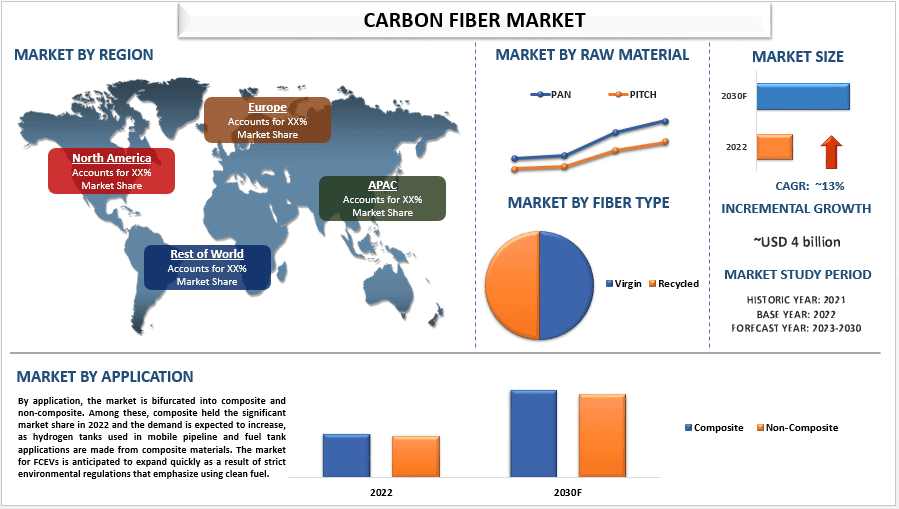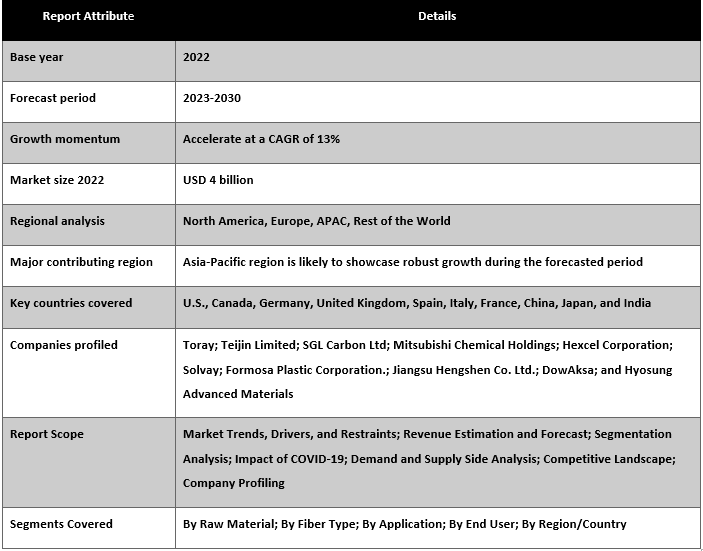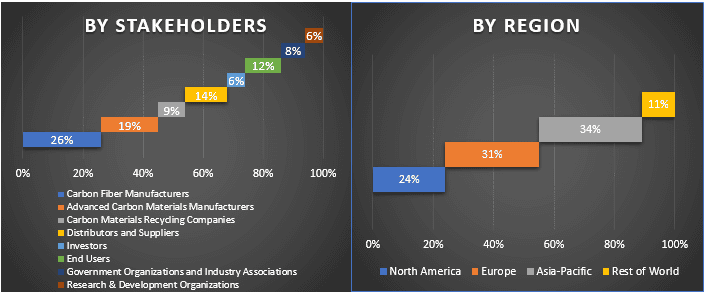
글로벌 탄소 섬유 시장은 2022년 약 40억 달러 규모였으며, 예측 기간(2023-2030) 동안 약 13%의 성장을 보일 것으로 예상됩니다.탄소 배출량 감소를 위해 각 국가는 기후 목표를 달성하겠다는 약속을 했습니다. 정부는 에너지 및 운송과 같은 다양한 분야에서 탄소 배출량을 줄이기 위해 여러 조치와 이니셔티브를 취하고 있습니다. 이러한 친환경적이고 지속 가능한 미래로의 전환은 첨단 탄소 재료에 대한 문을 열고 있습니다. 현재 에너지와 같은 산업은 풍력과 같은 재생 에너지에 점점 더 집중하고 있습니다. 이 분야에서 사용되는 많은 수의 구성 요소는 탄소 복합 재료를 사용하여 만들어져 경량화 및 고강도를 제공합니다. 또한, 자동차 산업은 차량 배출에 대한 엄격한 규제를 받고 있습니다. 따라서, 기업은 안전성과 성능을 유지하면서 연비를 개선하기 위해 차량 중량을 줄이고 있습니다.
탄소 섬유는 항공우주 및 방위, 자동차, 풍력 에너지, 스포츠, 전기 및 전자, 해양 등에서 사용됩니다. 따라서 수요는 이러한 산업에 크게 의존합니다. COVID-19의 영향으로, 이러한 산업 중 많은 곳이 폐쇄된 운영 또는 잠금 및 국경 폐쇄로 인한 원자재 부족으로 인해 부정적인 영향을 받았습니다.예를 들어, OICA에 따르면, 자동차 생산은 2020년에 16% 감소하여 탄소 섬유로 만들어진 것을 포함한 자동차 부품 시장을 저해했습니다..
보고서에 제시된 통찰력
“원자재 중, 폴리아크릴로나이트릴 (PAN) 범주는 2022년 시장에서 두드러진 점유율을 차지하고 있습니다.”
유형을 기준으로 시장은 PAN과 피치로 구분됩니다. 두 가지 중, PAN은 높은 수율과 높은 열 안정성, 낮은 밀도, 비용 효율성, 높은 저항 및 탄성 계수와 같은 여러 중요한 특성으로 인해 2022년 시장에서 주요 점유율을 차지했습니다.
“아시아 태평양 지역은 예측 기간 동안 강력한 성장을 보일 것으로 예상됩니다”
시장에 대한 더 나은 이해를 위해, 보고서는 북미(미국, 캐나다), 유럽(독일, 영국, 프랑스, 스페인, 이탈리아, 기타 유럽), 아시아 태평양(중국, 일본, 인도, 기타 아시아 태평양) 및 기타 지역을 포함한 주요 지역 및 국가에 대한 자세한 분석을 제공합니다. 예측 기간 동안, 아시아 태평양 지역은 다양한 최종 사용 산업의 수요 증가로 인해 강력한 성장을 보일 것으로 예상됩니다. 아시아 태평양 지역은 항공우주, 자동차, 풍력 에너지 및 스포츠 용품과 같은 산업에서 강력한 입지를 가지고 있으며, 이들은 탄소 섬유의 주요 소비자입니다. 이러한 산업에서 경량 및 고강도 재료에 대한 수요가 증가함에 따라 이 지역의 시장을 견인할 것으로 예상됩니다. 아시아 태평양 지역, 특히 중국, 일본 및 한국과 같은 국가는 탄소 섬유 생산 능력을 확장하기 위해 막대한 투자를 해왔습니다. 이들 국가는 잘 구축된 인프라, 기술 발전 및 원자재 접근의 이점을 가지고 있습니다. 이는 생산 능력 증가로 이어져 시장의 주요 업체가 되었습니다.
보고서 범위

이 보고서를 구매해야 하는 이유:
- 이 연구에는 인증된 주요 업계 전문가가 검증한 시장 규모 측정 및 예측 분석이 포함됩니다.
- 이 보고서는 전반적인 산업 성과를 한눈에 볼 수 있도록 간략하게 검토합니다.
- 이 보고서는 주요 비즈니스 재무, 제품 포트폴리오, 확장 전략 및 최근 개발에 중점을 둔 주요 업계 동료에 대한 심층 분석을 제공합니다.
- 업계에서 지배적인 동인, 제약, 주요 추세 및 기회에 대한 자세한 검토
- 이 연구는 다양한 세그먼트 전체의 시장을 포괄적으로 다룹니다.
- 업계에 대한 심층적인 국가 수준 분석
맞춤화 옵션:
글로벌 탄소 섬유 시장은 요구 사항 또는 기타 시장 부문에 따라 추가로 맞춤화될 수 있습니다. 이 외에도, UMI는 귀하가 귀하의 비즈니스 요구 사항을 가지고 있을 수 있음을 이해하므로, 귀하의 요구 사항에 완벽하게 맞는 보고서를 받기 위해 언제든지 저희에게 문의하십시오.
목차
글로벌 탄소 섬유 시장 분석 (2023-2030)을 위한 연구 방법론
과거 시장 분석, 현재 시장 추정, 탄소 섬유의 미래 시장 예측은 전 세계적으로 채택을 생성하고 분석하기 위해 수행되는 세 가지 주요 단계입니다. 광범위한 2차 연구가 과거 시장 수치를 수집하고 현재 시장 규모를 추정하기 위해 수행되었습니다. 둘째, 이러한 통찰력을 검증하기 위해 수많은 결과와 가정이 고려되었습니다. 또한, 탄소 섬유 산업의 가치 사슬 전반에 걸쳐 업계 전문가들과 광범위한 1차 인터뷰가 진행되었습니다. 1차 인터뷰를 통해 시장 수치를 가정하고 검증한 후, 우리는 완전한 시장 규모를 예측하기 위해 혼합된 접근 방식을 사용했습니다. 그 후, 시장 세분화 및 데이터 삼각 측량 방법을 채택하여 산업과 관련된 세그먼트 및 하위 세그먼트의 시장 규모를 추정하고 분석했습니다. 자세한 방법론은 다음과 같습니다.
과거 시장 규모 분석
1단계: 2차 자료에 대한 심층 연구:
탄소 섬유의 과거 시장 규모를 얻기 위해 다음과 같은 회사 내부 출처를 통해 자세한 2차 연구가 수행되었습니다.연간 보고서 및 재무 제표, 성과 발표, 보도 자료 등,그리고 다음을 포함한 외부 출처저널, 뉴스 및 기사, 정부 간행물, 경쟁사 간행물, 부문 보고서, 타사 데이터베이스 및 기타 신뢰할 수 있는 간행물.
2단계: 시장 세분화:
탄소 섬유 시장의 과거 시장 규모를 얻은 후, 우리는 주요 지역의 다양한 세그먼트 및 하위 세그먼트에 대한 현재 시장 통찰력과 점유율을 수집하기 위해 자세한 2차 분석을 수행했습니다. 보고서에 포함된 주요 세그먼트는 원자재, 섬유 유형, 응용 분야 및 최종 사용자입니다. 또한 탄소 섬유의 전반적인 채택을 평가하기 위해 지역 및 국가 수준의 분석이 수행되었습니다.
3단계: 요인 분석:
다양한 세그먼트 및 하위 세그먼트의 과거 시장 규모를 획득한 후, 우리는요인 분석탄소 섬유의 현재 시장 규모를 추정하기 위해. 또한, 우리는 산업에서 복합 재료의 수요 증가 및 경량 고강도 제품으로의 추세 전환과 같은 종속 및 독립 변수를 사용하여 요인 분석을 수행했습니다. 탄소 섬유 산업의 투자 증가, 주요 파트너십, 인수 합병, 사업 확장 및 제품 출시를 고려하여 수요 및 공급 측면 시나리오에 대한 철저한 분석이 수행되었습니다.
현재 시장 규모 추정 및 예측
현재 시장 규모 측정:위의 3단계에서 얻은 실행 가능한 통찰력을 바탕으로, 우리는 현재 시장 규모, 글로벌 탄소 섬유 시장의 주요 업체 및 각 세그먼트의 시장 점유율에 도달했습니다. 필요한 모든 비율 점유율 분할 및 시장 분석은 위에서 언급한 2차 접근 방식을 사용하여 결정되었으며 1차 인터뷰를 통해 검증되었습니다.
추정 및 예측:시장 추정 및 예측을 위해, 동인 및 추세, 제약 및 이해 관계자에게 제공되는 기회를 포함한 다양한 요인에 가중치가 할당되었습니다. 이러한 요인을 분석한 후, 관련 예측 기법, 즉, 하향식 접근 방식이 전 세계 주요 지역의 다양한 세그먼트 및 하위 세그먼트에 대한 2030년까지의 시장 예측에 적용되었습니다. 시장 규모를 추정하기 위해 채택된 연구 방법론은 다음을 포함합니다.
- 가치(US$) 측면에서의 산업 시장 규모 및 주요 시장 전반의 탄소 섬유 채택률
- 모든 비율 점유율, 시장 세그먼트 및 하위 세그먼트의 분할 및 분석
- 제공되는 제품 측면에서의 탄소 섬유 시장의 주요 업체. 또한, 빠르게 성장하는 시장에서 경쟁하기 위해 이러한 업체가 채택한 성장 전략.
시장 규모 및 점유율 검증
1차 연구:주요 지역의 최고위 임원(CXO/VP, 영업 책임자, 마케팅 책임자, 운영 책임자, 지역 책임자, 국가 책임자 등)을 포함한 핵심 오피니언 리더(KOL)와의 심층 인터뷰가 진행되었습니다. 1차 연구 결과를 요약한 후, 제시된 가설을 증명하기 위해 통계 분석을 수행했습니다. 1차 연구의 입력값은 2차 연구 결과와 통합되어 정보를 실행 가능한 통찰력으로 전환했습니다.
다양한 지역의 주요 참여자 분할

시장 공학
데이터 삼각 측량 기법을 사용하여 전체 시장 추정을 완료하고 글로벌 탄소 섬유 시장의 각 세그먼트 및 하위 세그먼트의 정확한 통계 수치를 얻었습니다. 데이터는 원자재, 섬유 유형, 응용 분야 및 최종 사용자의 다양한 매개변수와 추세를 연구한 후 여러 세그먼트 및 하위 세그먼트로 분할되었습니다.
탄소 섬유 시장 연구의 주요 목표
글로벌 탄소 섬유의 현재 및 미래 시장 동향이 연구에서 정확히 밝혀졌습니다. 투자자는 연구에서 수행된 질적 및 양적 분석을 통해 투자를 위한 재량권을 기반으로 전략적 통찰력을 얻을 수 있습니다. 현재 및 미래 시장 동향은 국가 수준에서 시장의 전반적인 매력을 결정하여 산업 참여자가 미개척 시장을 활용하여 선구자적 이점을 얻을 수 있는 플랫폼을 제공할 것입니다. 연구의 다른 양적 목표는 다음과 같습니다.
- 가치(US$) 측면에서 탄소 섬유의 현재 및 예측 시장 규모를 분석합니다. 또한, 다양한 세그먼트 및 하위 세그먼트의 현재 및 예측 시장 규모를 분석합니다.
- 연구의 세그먼트에는 원자재, 섬유 유형, 응용 분야 및 최종 사용자가 포함됩니다.
- 탄소 섬유 산업에 대한 규제 프레임워크의 정의된 분석
- 다양한 중개자의 존재와 관련된 가치 사슬을 분석하고 산업의 고객 및 경쟁사 행동을 분석합니다.
- 주요 국가에 대한 탄소 섬유의 현재 및 예측 시장 규모를 분석합니다.
- 보고서에서 분석된 주요 지역/국가에는 북미(미국, 캐나다), 유럽(독일, 영국, 프랑스, 스페인, 이탈리아, 기타 유럽), 아시아 태평양(중국, 일본, 인도, 기타 아시아 태평양) 및 기타 지역이 포함됩니다.
- 탄소 섬유 시장 참여자의 회사 프로필과 성장 시장에서 지속하기 위해 채택한 성장 전략
관련 보고서
이 상품을 구매한 고객님들도 함께 구매하신 상품










